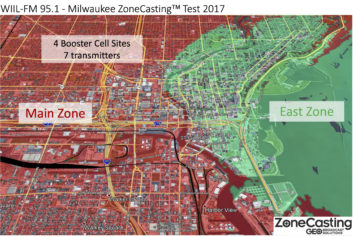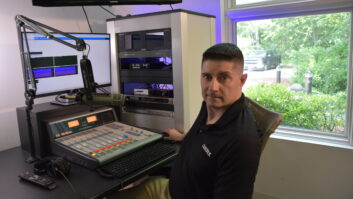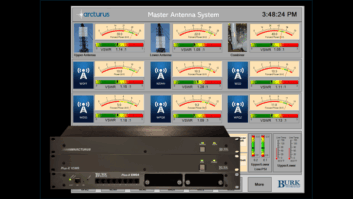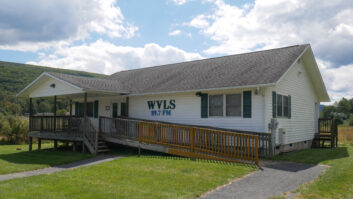
One of the topics for debate among technology leaders this spring — when they weren’t talking about face masks or hurriedly setting up remote operations — has been whether the Federal Communications Commission should allow zoned programming for FM stations in the United States.
The National Association of Broadcasters gave qualified support to the general concept but voiced concerns over potential interference. Separately, four prominent radio groups told the FCC that much more real-world data is necessary before the commission should even proceed to a notice of proposed rulemaking.
One veteran industry observer said the concept if approved could spark a “booster boom,” resulting in an increase in the number of booster facilities and modifications to existing boosters.
Cites Advertising Demand
The signal of an FM booster is used to strengthen reception within a station’s coverage contour on the same frequency as the primary station. Under current rules the booster must retransmit the same programming of the primary station.
Chicago-based GeoBroadcast Solutions, the company advocating the use of boosters to deploy geo-targeted content within specific parts of stations’ over-the-air coverage areas, petitioned the commission in March to consider the technical feasibility of its system, renewing an effort that goes back at least eight years. The commission then asked for industry comments about whether to take next steps.
GBS says its technology, marketed under the name ZoneCasting, would allow FM broadcasters to do “hyperlocal programming, advertising and emergency alerting,” or what it calls geo-fencing audio delivery. The company asserts that radio is the only mass medium that cannot geo-target its content. It favors a “voluntary, market-driven” transition; and says its zoned coverage would not cause harmful interference to neighboring FM stations or to the primary station.
“We are encouraged by the amount of support we received from the broadcast industry, as well as the advertising and public safety sectors.” — Bill Hieatt, CTO of GeoBroadcast Solutions
“The ongoing evolution of ZoneCasting and its ability to geo-target an analog or HD Radio signal is made by arranging transmitters in a cluster to allow programming in the zoned area to break away from the main signal and transmit geo-targeted content,” the company states in its promotional material.
“ZoneCasting works as a single-frequency network deployed to boost the signal from the main transmitter to the booster nodes.”
Launching the technology would only require one change to a subsection of the rules on boosters, it wrote in its petition for rulemaking in March.
The proposed revision adds the following language: “The programming aired on the FM broadcast booster station must be ‘substantially similar’ to that aired by its primary station. For purposes of this section, ‘substantially similar’ means that the programming must be the same except for advertisements, promotions for upcoming programs and enhanced capabilities including hyper-localized content (e.g., geo-targeted weather, targeted emergency alerts and hyperlocal news).” Such “fenced zones” could also be used for traffic information and second language programming, GBS has said.
GeoBroadcast supports its argument for using the geo-fencing audio technology by citing “interest and demand” by broadcasters and advertisers. It says research by BIA Advisory Services found that more than 90% of local retailers would spend more on broadcast radio advertising if zoned advertising were available. The study purports to show that “two-thirds of national advertisers indicated their interest in zoned broadcast coverage,” according to GeoBroadcast.
For precedent for its proposal, GeoBroadcast pointed to the FCC’s 2017 authorization to allow television broadcasters to use the Next Generation TV standard, also known as ATSC 3.0, which it said allowed for a higher level of service and benefits for consumers.
“Zoned broadcast coverage can be deployed without causing any interference concerns and without consumers having to buy any new equipment,” according to the filing, “since the signals can be received on existing radio receivers.” And when not operating in geo-targeting mode, the primary station’s signal is amplified, thus improving the signal in the area covered by the boosters at all times, it said.
The company says it has studied zoned broadcast coverage for a decade. Indeed, the commission did issue a notice of proposed rulemaking regarding the company’s technology in 2012 and collected comments, but took no further action at that time.
Now it says its development work through simulations and modeling, as well as test work including a five-site network at Entercom’s KWFN in San Diego, demonstrate that the concept works. GeoBroadcast has used “extensive network design work at NPR Labs to identify the power and height for the ZoneCasting boosters under a variety of primary station types and terrain conditions,” according to its filing.
“Field tests have shown that deployment of ZoneCasting does not result in harmful interference within the SFN either between the primary station and boosters or among the booster cluster itself,” it said.
Bert Goldman, president of Goldman Engineering Management, wrote in the GBS filing that “the ZoneCasting technology that broadcasters could deploy does not raise any technical concerns” that should hold up commission action (see below).
He told Radio World in an email the system uses the Synchrocast feature of GatesAir Intraplex codecs. “There is no other source that I know of which could supply that tight of a timing synchronization unless an RF STL link is used, but they typically use IP-based delivery,” Goldman wrote.
ZoneCasting currently works only with analog FM, but GeoBroadcast is working toward compatibility with digital radio systems, Goldman said.
The company’s ongoing testing “demonstrates the HD signal will work successfully with HD receivers in a ZoneCasting system,” according to a spokesman. “We are currently consulting with Xperi and infrastructure providers to ensure HD listeners will have a seamless listening experience.”
Supportive Words
GBS said the industry comments this spring demonstrated “general agreement” for innovative technologies and new paths for revenue. “Many of the detailed comments expressed anticipation for a level playing field in the broadcast industry and excitement for the ability to add localized weather and traffic, news, advertising, and emergency alerting during short parts of a broadcast hour, and the benefit it will offer listeners, small businesses and advertisers.”
Among those commenting in support, Sky Media LLC, licensee of KPKK(FM) in Amargosa Valley, Nev., wrote that it would “utilize zoned broadcast coverage to provide targeted emergency alerts, local news and public interest programming and localized advertisements responsive to the needs of small business.”
Another small broadcaster says the technology would bring numerous benefits to consumers. “Zoned coverage would make radio much more attractive to small businesses, who would be able to reach their targeted audiences more effectively and efficiently as well as local political candidates and local groups wishing to discuss localized issues affecting contiguous neighborhoods,” wrote Ashley Communications Inc., licensee of KLCY(FM) in Vernal, Utah.
The Multicultural Media, Telecom and Internet Council commented that “the ability to geo-target content on radio will be especially beneficial to minority broadcasters and their advertisers.”
Emmis Communications, which owns six FM and two AM radio stations, is in support, according to a letter to FCC Chairman Ajit Pai.
“From our company’s experience, this kind of geo-targeting could bring real benefits to the radio industry since it has the potential to address one drawback of the radio industry as it competes with other media: no ability to geo-target content and advertisements,” wrote Rick Cummings, director of programming for Emmis Communications.
Zoned advertising is a big part of the appeal here, and GBS noted support from advertising and marketing companies such as Ansira, Dentsu and MAGNA Global.
It also emphasizes the value in alerting. Craig Fugate, former director of the Federal Emergency Management Agency, told the FCC he believes geo-targeting is essential to allow regionalized alerts and warnings during times of emergency.
“In this era of hyper-local and targeted communications, radio has become the lone medium unable to reach its listeners on a granular basis. And, in fact, the value of geo-targeting through radio in times of local, regional, state, and federal emergencies is a paramount personal concern of mine,” wrote Fugate.
He continued, “Without a doubt, localized radio broadcast updates of today’s COVID-19 crisis would serve the public good by communicating public safety information pertinent to specific portions of the airwave’s audience. Consider the benefit of reaching a 25-mile portion of a radio signal about local test sites or shelters versus informing that same station’s 100-mile audience that do not need those specifics but require their own, zoned, details.”
Words of Caution
The National Association of Broadcasters supports giving FM broadcasters zoned broadcasting capabilities, but said the proposal is not entirely free of concerns.
The association noted its own previous opposition to the creation of a new Class C4 FM radio service due to an increased risk of interference to incumbent FM service — though in this case, it acknowledged, “any potential interference caused by using boosters to target content should only affect an FM station’s own service, and the decision whether to risk such self-interference would be purely voluntary,” NAB wrote.
It continued, “We also observe potential concerns that GBS’ system currently works only with analog FM service, which could undermine the continued expansion of digital audio broadcasting (DAB, also called HD Radio). There may be potential disruption to DAB in the targeted zones. This issue is not addressed in the petition.”
On balance, however, NAB favors the FCC granting the petition to move ahead to an NPRM.
GBS has, however, not yet made its case successfully to several of the country’s leading broadcasters.
iHeartMedia, Entercom Communications, Cumulus Media and Beasley Media Group jointly told the FCC that “more real-world vetting” is needed before the commission moves ahead even to an NPRM. The language in its filing was much more cautionary.
“Automatically authorizing such an unproven technology … is particularly premature given the proponent’s acknowledgment that listeners will experience some degree of ‘self-interference,’ as the booster signal is handed off from the primary programming to the zone programming.” — Joint filing by iHeartMedia, Cumulus, Entercom and Beasley
“Technologies that are not yet widely proven which could cause interference to the primary signal, as well as confusion among radio listeners as the primary signal is handed off to a localized signal, should not prematurely be adopted as a default standard without more real-world experience gathered with experimental authorizations,” they wrote.
“Automatically authorizing such an unproven technology … is particularly premature given the proponent’s acknowledgment that listeners will experience some degree of ‘self-interference,’ as the booster signal is handed off from the primary programming to the zone programming,” they wrote.
They acknowledged that GBS referenced studies of its technology but believes there has only been one “real-world” experimental test of its current iteration.
They said that by moving to an NPRM, the FCC would essentially endorse ZoneCasting “without the need for implementors to report back to the commission on the benefits, problems and/or weaknesses of the system.” They asked the FCC to allow more experimental authorizations and reporting, as it has done for technologies like Single Sideband Suppressed Carrier Modulation, all-digital on AM, Modulation Dependent Carrier Level controls and HD Radio.
Others raising concern include REC Networks, a low-power FM advocate. It said the booster rule change could lead to an increased risk of interference within the FM band and possibly bring on a “booster-boom” in the United States.
“(REC) must disagree in part with petitioner’s claims that ZoneCasting does not raise technical or interference issues and has ‘no impact on other broadcasters.’ There could be situations where the installation of an FM booster would create harmful interference to an LPFM station, mainly in cases where the full-service FM station was created or modified after the establishment date of the LPFM station,” wrote Michi Bradley, founder of REC Networks.
Commenting to Radio World about the general technical issues involved, Jim Stanley, president of Stanley Broadcast Engineering, said proper installation and maintenance of a station’s RF infrastructure will be critical to limiting self-interference when deploying such a system.
“Anytime multiple transmitters (boosters) are operated on the same frequency, synchronization is needed. This includes using GPS to phase lock the carriers and usually some type of audio delay in the input(s) of one or more transmitters.”
Stanley said, “When more than one transmitter is operated on the same frequency, with no geological terrain disruption between the two transmitter sites, there will be a certain amount of interference between the two signals where the contours meet. The degree of interference between multiple sites would vary depending on conditions. It is important that the booster sites be engineered and installed so that the booster coverage does not extend beyond the authorized 60 dBu contour of the primary facility.”
In a press release after the comment deadline, Bill Hieatt, CTO of GeoBroadcast Solutions, said, “The comments raised important issues for the industry as a whole and specific, instructive points on how our technology needs to address ideas and share knowledge to help it improve, as it has a chance to evolve in the marketplace.”
Making It Work
Bert Goldman, president of Goldman Engineering Management, has been working with GeoBroadcast since 2015 to develop multitransmitter booster systems known as MaxxCasting. He said ZoneCasting is based on that technology.
He told the FCC that MaxxCasting systems use boosters synchronized both with the main transmitter and with each other to produce seamless transitions between node areas. This, he said, improves coverage well beyond what would be possible with only the main transmitter by filling in low-signal areas within an FM station’s protected service contour.
He said the system is used successfully in numerous markets including Boston, Chicago, Los Angeles and Seattle “and is expanding rapidly.” Users, he said, report “vastly improved” quality of service and Nielsen PPM decoding.
Goldman said MaxxCasting achieves interference-free signal improvement due to four techniques that essentially “trick” a receiver into acting as if it is hearing one station instead of two or more, which would result in distortion and interference.
These techniques are carrier synchronization, which Goldman said is now possible by using GPS-trained oscillators; pilot phase synchronization, also possible using GPS; the use of small cells or “nodes” with highly directional antennas to keep the real-time FM waveforms at the receiver to within two microseconds; and maintaining audio modulation of the main and booster carriers to identical waveforms with less than a 0.1 dB difference between the main transmitter and all nodes.
On those last two points, Goldman added that recent technical advances play an important part.
“The technology to so precisely control the timing of the audio waveform for both analog stations and stations operating with HD Radio has only been perfected recently. Accurate RF modeling and prediction, critical in optimizing performance, is accomplished with powerful software tools developed by the wireless industry for cellular communications. This allows GeoBroadcast to precisely tailor parameters to maximize coverage and eliminate interference.”
“Modulation matching is also a recent development, made possible by digital composite and AES digital transmission, synchronization and high-speed data circuits.”
Comment on this or any story. Email [email protected] with “Letter to the Editor” in the subject line.







